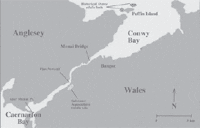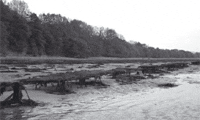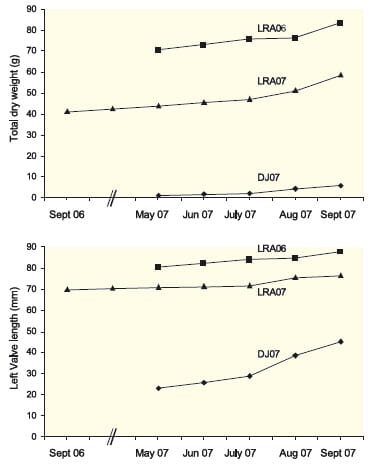Introduction

Despite of these issues, market place demand for native oysters remains high and, consequently, there is much interest in native oyster cultivation and, indeed, natural stock regeneration. According to the first UK fisheries survey carried out by Huxley in 1866 the native oyster was commercially fished in North Wales from beds in Caernarfon Bay and around Puffin Island (Fig. 1). However, nowadays there is certainly no oyster fishery in the locality and the native oyster populations are probably extinct. Nevertheless, because there were once commercial quantities of oysters in the region, and spat growth is known to be good in the Menai Strait, it is an ideal location for efforts to reintroduce the species.
Materials and Methods
In September 2006 and May 2007 adult native oysters were obtained from a wild managed fishery at Loch Ryan in Scotland (Rossmore Oysters Ltd) and were cultured in 1 m2, 4 mm mesh bags on low shore trestles at Saltwater Aquaculture positioned on the North shore of the Western Menai Strait (Fig. 1 & 2). The adult oysters acquired in September 2006 (herein designated LRA06) were stocked at densities of 50 individuals per m2 while those obtained in May 2007 (LRA07) were stocked at 100 individuals per m2. In May 2007 juvenile oysters, sourced from a pond-cultured population in the Limjford in Denmark (Veno Fish Farm Ltd), were introduced to the trestle site; this single batch of juvenile oysters (DJ07) was stocked at approximately 50 individuals per m2.

In order to assess the performance of the introduced adult and juvenile oysters random samples from each cultured batch were taken at the time of introduction to the trestle site and on a monthly basis, during spring tides, between May and September 2007. In all cases growth, in terms of change in the mean length of the left (cupped) valve (mm) and the total dry weight (g), and mean mortality rates were determined. In order to determine whether the adult oysters were reproducing successfully random individuals from both adult populations were taken between July and September 2007 and examined for the presence of brooded larvae. Immunological responses have been frequently used as indicators of the health of oysters and in the present study the changes in the numbers of free circulating haemocytes and the proportion of phagocytosing haemocytes, were determined for “mechanically-stressed” and “un-stressed” individuals from both adult populations in July 2007. It was anticipated that “stressed” oysters would have elevated numbers of circulating haemocytes and greater proportions of phagocytosing haemocytes when compared to their unstressed counterparts. Such significant responses would show the oyster population to be immunocompetent and so capable of responding to stresses within their environment. Conversely, immunosuppressed populations would not exhibit significant immunological responses indicating their inability to cope with adverse changes.
Results and Discussion
Growth
The mean dry flesh weight (g) of the cultured juvenile Danish oysters (DJ07) was shown to increase significantly from 0.015 g in May 2007 to 0.156 g in September of the same year. This 10.4 fold weight increase in 4 months (Fig. 3) is similar to the growth rates found by others (Utting in 1988 and Beaumont & Gowland in 2002). Over the same period the mean length of the left (cupped) valve (mm) of the juvenile O. edulis almost doubled in size from 23 mm to 45.3 mm (Fig. 3).

The LRA06 population, which were re-laid in September 2006, showed a mean weight gain of more than 17 g (Fig. 3) and increased in mean shell length from 70 mm to 77 mm by the final sampling date in September 2007 (Fig. 3). The mean shell length of LRA07 oysters was found to increase by 7 mm since the time of relaying in May 2007 to 87.4 mm in September of the same year (Fig. 3) while the total weight gain was approximately 13 g (Fig. 3). As was the case for the juvenile DJ07 oysters the growth rates of the cultured adult populations are encouraging when compared to those of previous studies. For example, Briggs in 1978 described “favourable” performance of native oysters in growth trials in Strangford Lough with individuals < 50 mm in length, maintained in oyster trays elevated above the seabed, gaining approximately 12 g in weight between June and August. Considering that the main growing season of O. edulis in Britain occurs between June and September the growth rates of adult O. edulis found in the current study are similar to those reported in Strangford Lough. Indeed, the average growth rate expected of O. edulis in Britain is ~ 20 g yr-1 and in the current study the LRA07 population achieved 65 per cent of this average annual growth within 4 months (mid May to mid September 2007) highlighting the potential of the Menai Strait as a suitable location for culturing native oysters.
Immunocompetence
Immunological investigations of the trestlemaintained adult oysters showed the blood counts (the numbers of free circulating haemocytes) of “stressed” LRA06 and LRA07 individuals were 30 per cent and 25 per cent greater than their non-stressed counterparts respectively. This increase was statistically significant for the LRA07 population. In the phagocytosis assay, the stressed oysters in both populations exhibited increased proportions of phagocytosing haemocytes, significantly so in the LRA06 oysters. Despite the apparent disparity in the results of the immunocompetence investigations the favourable growth rates exhibited by both oyster populations suggests that the oysters were in fact healthy (immunocompetent) and, indeed, thriving at the trestle site.
Mortality And Reproduction
The mean mortality rates of the three populations of trestle maintained oysters were very low (between 0.67 and 4 per cent). Examination of random samples of adult oysters collected between July and September 2007 showed that the introduced populations had successfully spawned with the overall proportion of brooding oysters ranging from none to a maximum of 29 per cent. Over the duration of the experiment no significant difference was found in the proportions of brooding LRA07 individuals, which ranged from a minimum of 11.1 per cent in July to a maximum of 20 per cent in September. In the case of LRA06 oysters no brooding oysters were observed in July, however, the percentage of brooding oyster increased in August to approximately 17 per cent and reached a maximum of 29 per cent in September. In neither population was there a significant pattern of increase in the proportions of brooding oysters over the duration of the trials, nor did the changes in proportions of brooding oysters differ between the two populations.
February 2009



